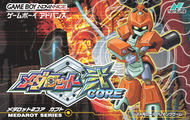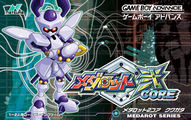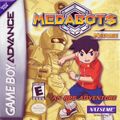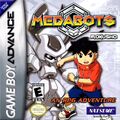Medarot 2 Core: Difference between revisions
Metal Beetle (talk | contribs) No edit summary |
mNo edit summary |
||
| Line 6: | Line 6: | ||
|genre = RPG | |genre = RPG | ||
|platform = Game Boy Advance | |platform = Game Boy Advance | ||
|developer = Natsume | |developer = [[Natsume]] | ||
|publisher = Imagineer | |publisher = [[Imagineer]] (Japan) <br> [[Natsume Inc]] (North America) <br> [[wikipedia:Ubisoft|Ubisoft]] (Europe) | ||
|date = EU: November 22 2002 <br/> JP: December 25, 2002 (BomBom edition) <br/> NA: March 31 2003 <br/> JP: April 18 2003 (Retail edition) <br/> JP: January 2016 (Wii U Virtual Console) | |date = EU: November 22 2002 <br/> JP: December 25, 2002 (BomBom edition) <br/> NA: March 31 2003 <br/> JP: April 18 2003 (Retail edition) <br/> JP: January 2016 (Wii U Virtual Console) | ||
}} | }} | ||
Revision as of 18:50, 16 September 2024
| Medarot 2 Core / Medabots メダロット弐CORE | |
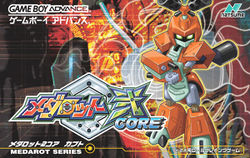
| |
| Genre | RPG |
|---|---|
| Platform | Game Boy Advance |
| Developer | Natsume |
| Publisher | Imagineer (Japan) Natsume Inc (North America) Ubisoft (Europe) |
| Release Date | EU: November 22 2002 JP: December 25, 2002 (BomBom edition) NA: March 31 2003 JP: April 18 2003 (Retail edition) JP: January 2016 (Wii U Virtual Console) |
Medarot 2 Core, released in English as Medabots: Metabee Version and Medabots: Rokusho Version, is probably the most well-known Medarot game. It was developed by Natsume and published by Imagineer for the Game Boy Advance, and was the first Medarot RPG to be released in English. As the name implies, it is a remake of Medarot 2, featuring updated graphics and gameplay.
The graphics style closely matches that of the anime series, and several Medarots from Medarot 1 that had appeared in the anime were made obtainable in the game. Otherwise, the story remains untouched from Medarot 2.
Like the other RPGs, the game was released in two versions where the main difference is the player's starting Medarot: Kabuto (Rhinoceros beetle, Metabee) and Kuwagata (Stag beetle, Rokusho). In the English release, they were simply referred to as the Metabee and Rokusho versions. Along with the starting Medarots, there are some Medarots and Medals that can only be obtained in a specific version.
In an interesting turn of events, the English versions were actually released first, and Japan got it almost 5 months later.
Selection of Medarots
- Main article: Medarots in Medarot 2 Core
For the most part, Medarot 2 Core features the same set of Medarots as Medarot 2. However, some Medarot 2-exclusive models were left out in favor of their Medarot 1 counterparts, which in many cases had appeared in the anime series and were therefore more recognizable. (For example, HellPhoenix takes the place of DeathPhoenix)
In Medarot 2, every Medarot from Medarot 1 was technically obtainable, but it required trading them over from the first game. In Medarot 2 Core, 21 of the Medarots from the first game were completely removed, but the remaining 39 were made possible to obtain normally without trading (unless version exclusive). There were also 10 Medarots added in Medarot 2 that could only be obtained using passwords, which were also made normally obtainable in 2 Core. As a result, the remake may have fewer total Medarots, but it has many more obtainable Medarots than the original Game Boy game.
Changes
Medarot 2 Core incorporates many of the gameplay changes that happened in Medarot 3-5, while keeping the content similar to what it was in the original game.
From Medarot 2
- The battle system has been updated, making it somewhat closer to the later Game Boy games.
- The "Other" skill has been replaced with Disrupt.
- Players name their Medals instead of their Tinpets.
- Medals' actions during an Auto-battle can be set using the Rotation menu.
Continuity and Placement
As a remake of Medarot 2, the events in the game are set 13 years after the beginning of Medarot 1. However, the localized version shortens the timeline to 9 years to align with the anime's narrative.
The game pays tribute to the anime, resulting in some canonical changes, most of which are aesthetic and do not affect the main plot. For example, RoboRobo grunts wear black uniforms instead of green, and some characters use Medarots from M1 instead of M2, reflecting the anime's preference for showcasing more models from the first game.
Ultimately, as a remake, Medarot 2 Core complements the original Medarot 2. In cases of conflicting information, the original Medarot 2's details likely prevail since there have been no remakes of Medarot 3 and Medarot 4 to support these changes in the timeline.
Japanese version differences
A special version of the Japanese game was sold through Comic BomBom prior to the game's release. The manual from this special edition came with eight extra pages that include a signature by Horuma Rin, a timeline of the game's events, and some details about content found after completing the game, such as Belzelga and Wonder Angel. This version also featured the names of everyone who ordered the special edition in the game credits. The normal edition was released in stores some months later.
An extra post-game event exists in the Japanese games that isn't present in the English version. It involves talking to Milky who summons a mysterious masked Medarotter from the future (actually Koishimaru from Medarot 5, which was set several years after Medarot 2). Ikki then battles Koishimaru who uses an exact copy of the player's current team.
Pressing select on the parts screens also displays the part's model number. Presumably this was left out of the English version due to the model numbers being changed in the English version of the anime.
Gallery
Box Art
-
Kabuto version
-
Kuwagata version
-
Medabots Metabee version
-
Medabots Rokusho version
Screen
-
Medarot 2 Core Title Screen (Kabuto)
-
Medarot 2 Core Title Screen (Kuwagata)
-
Medabots Title Screen (Metabee)
-
Medabots Title Screen (Rokusho)
See also
External links
- Official site (archive)
| Video Games View - Edit | |
|---|---|
| Main series / Parts Collections |
Medarot 1 (PC / PC2) - Medarot 2 (PC) - Medarot R (PC) - Medarot 3 (PC) - Medarot 4 Medarot 5 - Medarot DS - Medarot 7 - Medarot 8 - Medarot 9 |
| Side games | Medarot Navi - Shingata Medarot - Medarot S: Unlimited Nova |
| Remakes | Medarot Perfect Edition - Medarot 2 Core |
| Action games | Metabee Shot - Medarot G - Medabots AX - Medarot Brave - Medarot Dual - Medarot Girls Mission |
| Collections | Medarot Classics - Medarot Classics Plus |
| Other games | Medarot Cardrobottle - Pocket Robottle - Robattle 3D - Medarotch |
